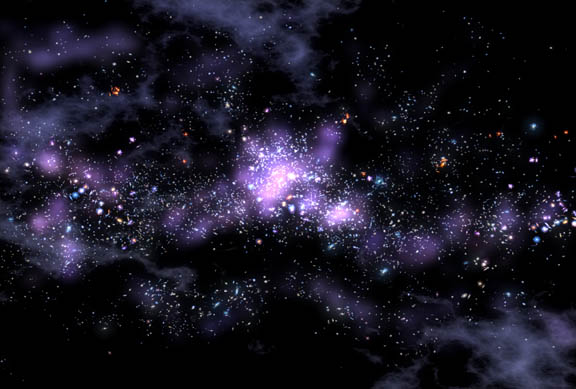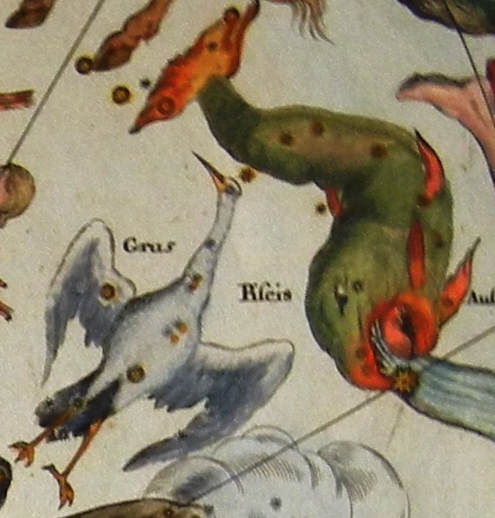|
Grus Wall
The Grus Wall is a superstructure of galaxies (" wall of galaxies") formed in the early universe, named for the Grus constellation in which it is found ("grus" is Latin for "crane"). It has an average redshift of z=2.38 and lies about 10.8 billion light-years away. The Wall is around 300 million light-years long, comparable in size to the Sloan Great Wall. The Wall is "perpendicular" to the Fornax Wall and Sculptor Wall The Sculptor Wall is a superstructure of galaxies ( "wall of galaxies") relatively near to the Milky Way Galaxy (redshift In physics, a redshift is an increase in the wavelength, and corresponding decrease in the frequency and photon energy .... The Grus Wall was discovered in 2003 by Povilas Palunas, Paul Francis, Harry Teplitz, Gerard Williger, and Bruce E. Woodgate through the use of wide-field telescopes. Further reading * References {{galaxy-stub Galaxy filaments ... [...More Info...] [...Related Items...] OR: [Wikipedia] [Google] [Baidu] |
Galaxies
A galaxy is a system of stars, stellar remnants, interstellar gas, dust, and dark matter bound together by gravity. The word is derived from the Greek ' (), literally 'milky', a reference to the Milky Way galaxy that contains the Solar System. Galaxies, averaging an estimated 100 million stars, range in size from dwarfs with less than a thousand stars, to the largest galaxies known – supergiants with one hundred trillion stars, each orbiting its galaxy's centre of mass. Most of the mass in a typical galaxy is in the form of dark matter, with only a few per cent of that mass visible in the form of stars and nebulae. Supermassive black holes are a common feature at the centres of galaxies. Galaxies are categorised according to their visual morphology as elliptical, spiral, or irregular. The Milky Way is an example of a spiral galaxy. It is estimated that there are between 200 billion () to 2 trillion galaxies in the observable universe. Most galaxies are 1,000 to 10 ... [...More Info...] [...Related Items...] OR: [Wikipedia] [Google] [Baidu] |
Wall Of Galaxies
In cosmology, galaxy filaments are the largest known structures in the universe, consisting of walls of galactic superclusters. These massive, thread-like formations can commonly reach 50 to 80 megaparsecs ()—with the largest found to date being the Hercules-Corona Borealis Great Wall at around in length—and form the boundaries between voids. Due to the accelerating expansion of the universe, the individual clusters of gravitationally bound galaxies that make up galaxy filaments are moving away from each other at an accelerated rate; in the far future they will dissolve. Galaxy filaments form the cosmic web and define the overall structure of the observable universe. Discovery Discovery of structures larger than superclusters began in the late 1980s. In 1987, astronomer R. Brent Tully of the University of Hawaii's Institute of Astronomy identified what he called the Pisces–Cetus Supercluster Complex. The CfA2 Great Wall was discovered in 1989, followed by the Sloan Grea ... [...More Info...] [...Related Items...] OR: [Wikipedia] [Google] [Baidu] |
Grus (constellation)
Grus (, or colloquially ) is a constellation in the southern sky. Its name is Latin for the crane (bird), crane, a type of bird. It is one of twelve constellations conceived by Petrus Plancius from the observations of Pieter Dirkszoon Keyser and Frederick de Houtman. Grus first appeared on a celestial globe published in 1598 in Amsterdam by Plancius and Jodocus Hondius and was depicted in Johann Bayer's star atlas ''Uranometria'' of 1603. French explorer and astronomer Nicolas-Louis de Lacaille gave Bayer designations to its stars in 1756, some of which had been previously considered part of the neighbouring constellation Piscis Austrinus. The constellations Grus, Pavo (constellation), Pavo, Phoenix (constellation), Phoenix and Tucana are collectively known as the "Southern Birds". The constellation's brightest star, Alpha Gruis, is also known as Alnair and appears as a 1.7-Apparent magnitude, magnitude blue-white star. Beta Gruis is a red giant variable star with a minimum mag ... [...More Info...] [...Related Items...] OR: [Wikipedia] [Google] [Baidu] |
Latin
Latin ( or ) is a classical language belonging to the Italic languages, Italic branch of the Indo-European languages. Latin was originally spoken by the Latins (Italic tribe), Latins in Latium (now known as Lazio), the lower Tiber area around Rome, Italy. Through the expansion of the Roman Republic, it became the dominant language in the Italian Peninsula and subsequently throughout the Roman Empire. It has greatly influenced many languages, Latin influence in English, including English, having contributed List of Latin words with English derivatives, many words to the English lexicon, particularly after the Christianity in Anglo-Saxon England, Christianization of the Anglo-Saxons and the Norman Conquest. Latin Root (linguistics), roots appear frequently in the technical vocabulary used by fields such as theology, List of Latin and Greek words commonly used in systematic names, the sciences, List of medical roots, suffixes and prefixes, medicine, and List of Latin legal terms ... [...More Info...] [...Related Items...] OR: [Wikipedia] [Google] [Baidu] |
Redshift
In physics, a redshift is an increase in the wavelength, and corresponding decrease in the frequency and photon energy, of electromagnetic radiation (such as light). The opposite change, a decrease in wavelength and increase in frequency and energy, is known as a #Blueshift, blueshift. The terms derive from the colours red and blue which form the extremes of the Visible spectrum, visible light spectrum. Three forms of redshift occur in astronomy and cosmology: Doppler effect, Doppler redshifts due to the relative motions of radiation sources, gravitational redshift as radiation escapes from gravitational potentials, and cosmological redshifts of all light sources proportional to their distances from Earth, a fact known as Hubble's law that implies the expansion of the universe, universe is expanding. All redshifts can be understood under the umbrella of Frame of reference, frame transformation laws. Gravitational waves, which also travel at Speed of light, the speed of light, a ... [...More Info...] [...Related Items...] OR: [Wikipedia] [Google] [Baidu] |
Light-year
A light-year, alternatively spelled light year (ly or lyr), is a unit of length used to express astronomical distances and is equal to exactly , which is approximately 9.46 trillion km or 5.88 trillion mi. As defined by the International Astronomical Union (IAU), a light-year is the distance that light travels in vacuum in one Julian year (365.25 days). Despite its inclusion of the word "year", the term should not be misinterpreted as a unit of time. The ''light-year'' is most often used when expressing distances to stars and other distances on a galactic scale, especially in non-specialist contexts and popular science publications. The unit most commonly used in professional astronomy is the parsec (symbol: pc, about 3.26 light-years). Definitions As defined by the International Astronomical Union (IAU), the light-year is the product of the Julian year (365.25 days, as opposed to the 365.2425-day Gregorian year or the 365.24219-day Tropical year that both approxim ... [...More Info...] [...Related Items...] OR: [Wikipedia] [Google] [Baidu] |
Sloan Great Wall
The Sloan Great Wall (SGW) is a cosmic structure formed by a giant wall of galaxies (a galaxy filament). Its discovery was announced from Princeton University on October 20, 2003, by J. Richard Gott III, Mario Jurić, and their colleagues, based on data from the Sloan Digital Sky Survey. Size The wall measures in length, located approximately one billion light-years away. In the sky, it is located within the region of the constellations Corvus, Hydra and Centaurus. It is approximately 1/60 of the diameter of the observable universe, making it the sixth largest known object after the large quasar groups Clowes-Campusano LQG, U1.11, Huge-LQG, the Giant GRB Ring and the galaxy filament Hercules–Corona Borealis Great Wall (Her-CrB GW), respectively. The Sloan Great Wall is between 1.8–2.7 times longer than the CfA2 Great Wall of galaxies (discovered by Margaret Geller and John Huchra of Harvard University in 1989). It also contains several galactic superclusters, th ... [...More Info...] [...Related Items...] OR: [Wikipedia] [Google] [Baidu] |
Fornax Wall
The Fornax Wall is a superstructure known as a galaxy filament or galaxy wall. It is a long filament of galaxies with a major axis longer than its minor one. The filament contains not only Dorado Group but also the Fornax Cluster of galaxies, which lies at the same distance. It is "parallel" to the Sculptor Wall and "perpendicular" to the Grus Wall The Grus Wall is a superstructure of galaxies (" wall of galaxies") formed in the early universe, named for the Grus constellation in which it is found ("grus" is Latin for "crane"). It has an average redshift of z=2.38 and lies about 10.8 billion .... References {{galaxy-stub Galaxy filaments Southern Supercluster ... [...More Info...] [...Related Items...] OR: [Wikipedia] [Google] [Baidu] |
Sculptor Wall
The Sculptor Wall is a superstructure of galaxies ( "wall of galaxies") relatively near to the Milky Way Galaxy (redshift In physics, a redshift is an increase in the wavelength, and corresponding decrease in the frequency and photon energy, of electromagnetic radiation (such as light). The opposite change, a decrease in wavelength and increase in frequency and e ... of approximately z=0.03), also known as the Sculptor superclusters. (slices 8 and 10 under SGH) The superstructure is also called the Southern Great Wall, the Great Southern Wall, or just the Southern Wall, in reference to the Northern Great Wall. The structure is 8000 km/s long (where km/s indicates the rate of expansion between two objects at the extents of a superstructure), 5000 km/s wide, 1000 km/s deep, in ''redshift space'' dimensions. Because these structures are so large, it is convenient to estimate their size by measuring their redshift; using a value of 67.8 for Hubble's constant, t ... [...More Info...] [...Related Items...] OR: [Wikipedia] [Google] [Baidu] |
Bruce Woodgate
Bruce E. Woodgate (1939 – April 28, 2014) was a British-born American aerospace engineer, inventor and astronomer, who worked at NASA's Goddard Space Flight Center for forty years. He was the principal investigator of the Space Telescope Imaging Spectrograph (STIS), a spectrograph and camera which was installed on the Hubble Space Telescope in 1997. Woodgate oversaw the design, development and construction of the STIS. Astronomers and other scientists have used the STIS to study and measure a wide range of light wavelengths in deep space. Woodgate's invention has been called a "game changer" in the field of astronomy, allowing scientists to discover an "invisible high-speed collision" near SN 1987A, as well as new planets and black holes. A power failure knocked STIS offline in 2004, but it was repaired in 2009. Aside his from his work as the principal investigator on STIS, Woodgate had also begun development on a new UV detector which counts protons utilizing new nano-fabrica ... [...More Info...] [...Related Items...] OR: [Wikipedia] [Google] [Baidu] |








